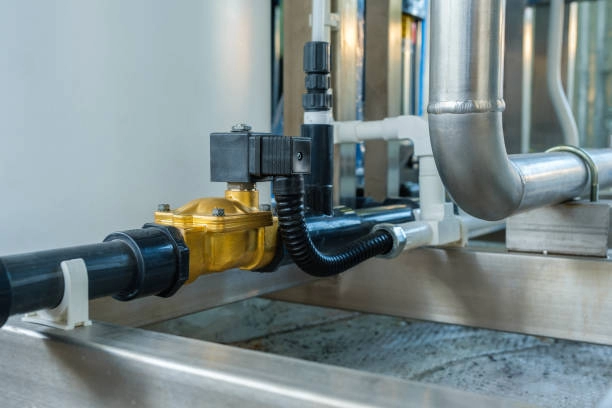
Saving Energy with your Hydraulic System
2024-04-18Hydraulic system is a transmission method widely used in the world. However, problems such as high energy consumption, high noise, high temperature and easy leakage of hydraulic systems seriously affect their reliability and safety. In order to study the energy-saving technology of hydraulic systems, this article researches and analyzes the principles, energy-saving technologies and application fields of hydraulic systems.
Principle of hydraulic system
The hydraulic system is an energy transfer and control system based on the principles of liquid fluid mechanics.
The hydraulic system consists of five parts: power source, actuator, hydraulic components, control components and oil circuit.
Among them, the power source provides the energy to drive the hydraulic pump, compressing the liquid into a high-pressure, high-flow liquid flow; hydraulic components include hydraulic cylinders, hydraulic motors, hydraulic pressure, etc., which output the compressed liquid as force or work to complete mechanical movement; The actuator is the output part of the hydraulic system, used to complete mechanical movement, force action or energy conversion; control components include hydraulic solenoid valves, hydraulic proportional valves, etc., used to control and adjust parameters such as pressure, flow, direction, speed, etc. ; The oil circuit is the channel for transmitting and controlling energy in the hydraulic system, connecting hydraulic components, control components and actuators.
Energy-saving technology of hydraulic system
Improvement of hydraulic system efficiency
The improvement of hydraulic system efficiency is the fundamental guarantee for energy saving. Generally speaking, the efficiency of a hydraulic system includes three aspects: pressure energy conversion efficiency, power energy conversion efficiency and total efficiency. Pressure energy conversion efficiency refers to the ability of the hydraulic system to convert pressure energy into work during work, which depends on the pressure loss of the system; power energy conversion efficiency refers to the ability of the hydraulic system to convert the energy provided by the power source into mechanical energy during work, which depends on The oil delivery volume and flow rate of the system; the overall efficiency refers to the ability of the hydraulic system to minimize energy loss during work.
Improvements in hydraulic system efficiency can be achieved through the following methods:
(1) Select appropriate pumps and actuators. Using low-consumption pumps and low-consumption actuators improves system efficiency and reduces leakage.
(2) Reasonably design the pipeline to reduce resistance. Shortening the pipeline path and reducing bends and roughness can reduce pipeline resistance and pressure loss.
(3) Increase system pressure. Increasing pressure in a hydraulic system can improve efficiency, but system design needs to be optimized to avoid problems such as increased leakage and noise.
Application of energy-saving components in hydraulic systems
The application of energy-saving components in hydraulic systems is also an effective way to achieve energy saving in hydraulic systems, including the following aspects:
(1) Proportional hydraulic valve. Proportional hydraulic valves use computer technology to control pressure, flow, speed and other parameters in real time according to demand, reducing energy consumption and noise in the hydraulic system.
(2) Hydraulic cylinder rod suspension system. The hydraulic cylinder rod suspension system balances the fluid pressure inside the hydraulic cylinder with external loads (such as heavy objects) by adjusting the pressure of the rod plug. This design reduces the energy consumption of the system and improves efficiency.
(3) Speed control of hydraulic station. The speed control of the hydraulic station can realize flow control and pressure control, improving the efficiency and control accuracy of the hydraulic system.
(4) Hydraulic filter. Hydraulic filters remove impurities and moisture from the oil, reduce dissipation, and reduce energy consumption and noise.
System optimization of hydraulic system
System optimization of the hydraulic system is an energy-saving technology with clear goals. The specific implementation process includes the following steps:
(1) Analyze the working conditions and processes of the system and determine the target requirements and constraints.
(2) Establish a model of the hydraulic system, simulate and analyze it, and find out the main sources and influencing factors of energy consumption.
(3) Analyze the status parameters of the hydraulic system, select appropriate control methods, and achieve optimal control.
(4) Design and select appropriate components, adjust and optimize the structure and parameters of the system, and achieve energy-saving goals.
(5) Use advanced monitoring and diagnostic technology to monitor and evaluate the hydraulic system in real time to ensure the reliability and safety of the system.

Application fields of hydraulic system energy-saving technology
The main application fields of hydraulic system energy-saving technology include:
(1) Machine tool manufacturing. Hydraulic systems are widely used in machine tool manufacturing, such as milling machines, grinders, lathes, drilling machines, etc. The use of hydraulic system energy-saving technology can reduce problems such as noise, temperature, vibration and leakage of machine tools, and improve the processing accuracy and efficiency of machine tools.
(2) Construction machinery. Engineering machinery such as excavators, loaders, bulldozers, road rollers, etc. are widely used in engineering construction. The use of hydraulic system energy-saving technology can improve the efficiency and performance of the entire machine, saving fuel costs and maintenance costs.
(3) Ships and locomotives. Hydraulic systems play an important role in ships and locomotives, such as hoisting mechanisms, winches, brakes, etc. The use of hydraulic system energy-saving technology can improve the operating efficiency and safety of ships and locomotives.
(4) Mining and metallurgy. Hydraulic systems are often used in mining and metallurgical production, such as mine cars, railway trucks, metallurgical equipment, etc. The use of hydraulic system energy-saving technology can improve the efficiency and stability of equipment, saving energy and costs.
Development trends of energy-saving technology in hydraulic systems
The development trends of hydraulic system energy-saving technology include:
(1) Apply digital technology. The application of digital technology can achieve refined control and optimized design of the hydraulic system to achieve optimal results.
(2) Research on energy-saving hydraulic components. With the development of technology. The research and design of hydraulic components are also constantly updated, such as energy-saving hydraulic pumps, energy-saving hydraulic valves, etc.
(3) Apply intelligent sensors and networked control technology. The application of intelligent sensors and networked control technology can realize real-time monitoring, remote control and management of hydraulic systems.
(4) Apply new materials and coating technologies. The application of new materials and coating technologies can improve the sealing, low friction and corrosion resistance of hydraulic systems, reducing leakage and energy consumption. In short, energy-saving technology in hydraulic systems is an important way to achieve high efficiency, reliability, safety, environmental protection and energy saving. With the development of science and technology and the continuous promotion of applications, hydraulic system energy-saving technology will be applied and developed in a wider range of fields.




